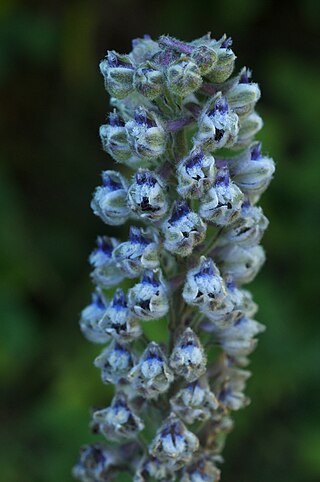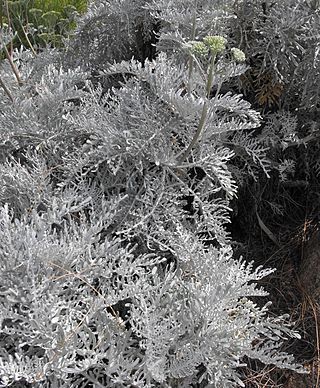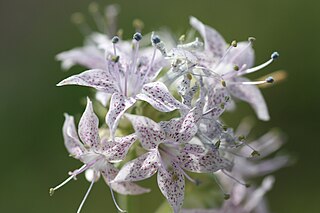
Delphinium andersonii is a species of perennial larkspur known as Anderson's larkspur. This wildflower is native to western North America, where it can be found in the Great Basin and the Sierra Nevada.

Delphinium californicum is a species of larkspur known as California larkspur. This wildflower is endemic to California, where it is a resident of the chaparral slopes of the San Francisco Bay Area and Central Coast.

Delphinium cardinale is a species of larkspur known by the common names scarlet larkspur and cardinal larkspur. This wildflower is native to California and Baja California, where it grows on coastal, inland, and desert chaparral slopes, such as the Colorado Desert, and the Peninsular and Transverse Ranges. The presence of diterpenoid alkaloids, probably including the highly toxic methyllycaconitine, in above-ground parts of D. cardinale means that they are likely to be toxic if ingested.
Delphinium decorum is a species of larkspur known by the common names coastal larkspur and yellow-tinge larkspur. This wildflower is native to California and Oregon, where it grows on the slopes of the coastal ranges from the San Francisco Bay Area north to the southern Oregon coast. It has an erect stem which approaches half a meter in height at maximum. The leaves, which are divided into a number of narrow lobes, are mostly located about the base of the plant. The spindly stem above bears two to twenty widely spaced flowers. Each flower is carried on a pedicel several centimeters long. The five long, flat sepals are extended to give the face of the flower a star shape, and they are usually deep blue to purple. The petals are similar in color, except the top two may be lighter to almost white. The spur is very thin and may be nearly two centimeters long.
Delphinium hutchinsoniae is a rare species of larkspur known by the common names Monterey larkspur and Hutchinson's larkspur. It is endemic to California, where it is known only from Monterey County. This wildflower reaches a meter in height but is usually shorter. The leaves are divided into lobes which are further divided into smaller lobes, and they are mostly located low on the plant. The top of the thin, erect stem is occupied by an inflorescence of not more than ten flowers. Each flower has sepals which are brilliant purple or blue to lavender, two petals which are the same color, and two upper petals which are usually white. The spur is up to two centimeters long and curves down at the tip.

Delphinium uliginosum is a species of larkspur known by the common names swamp larkspur and bog larkspur. It is endemic to California, where it is known from very localized populations in the Inner North Coast Ranges. It grows in chaparral, grassland, and other habitat in the hills, generally on serpentine soils. This is a perennial herb producing a hairless, erect stem up to 70 centimeters tall. It can be identified by its leaves, which are fan-shaped, a characteristic unique among the larkspurs, which generally have palmate leaves with narrow, fingerlike lobes. The inflorescence bears up to 45 flowers, each on an upright pedicel which may exceed 10 centimeters long. The flower is blue with the longest sepals 1.4 centimeters long and a spur about the same length. The fruit is one or two centimeters long.

Constancea is a monotypic genus of flowering plants in the family Asteraceae containing the single species Constancea nevinii, which is known by the common name Nevin's woolly sunflower. It is endemic to three of the Channel Islands of California, where it grows in coastal scrub habitat. This is a small shrub or subshrub generally growing up to one or 1.5 meters tall, and taller when an erect form, with a branching, woolly stem. The whitish, woolly oval leaves may be up to 20 centimeters long and are divided into many narrow lobes with edges curled under. The inflorescence is a cluster of 10 to 50 or more small flower heads, each on a short peduncle. The flower head has a center of hairy, glandular, star-shaped yellow disc florets and a fringe of four to nine yellow ray florets, each about 2 millimeters long. The fruit is an achene a few millimeters long with a small pappus at the tip.

Leptosiphon acicularis is a species of flowering plant in the phlox family known by the common names bristly linanthus and bristly leptosiphon.

Leptosiphon ciliatus is a species of flowering plant in the phlox family known by the common name whiskerbrush.
Diplacus johnstonii is a species of monkeyflower known by the common name Johnston's monkeyflower.

Ribes sericeum is a species of currant known by the common name Lucia gooseberry, or Santa Lucia gooseberry; its Latin epithet of sericeum means "of silk". It is endemic to California, where it is known only from the Santa Lucia Mountains along the Central Coast and an additional isolated population in Santa Barbara County.

Ribes velutinum is a species of currant known by the common name desert gooseberry.

Packera breweri is a species of flowering plant in the aster family known by the common name Brewer's ragwort. It is endemic to central California, where it occurs in the woodlands and grasslands of the Central Coast Ranges. They are more frequently found in mid-southern counties of California near the coast, such as Kern or Monterey.
Silene serpentinicola is a rare species of flowering plant in the family Caryophyllaceae known by the common name serpentine Indian pink and serpentine catchfly.
Streptanthus farnsworthianus is an uncommon species of flowering plant in the mustard family known by the common name Farnsworth's jewelflower. It is endemic to California, where it is limited to the woodlands of the Sierra Nevada foothills. It is an annual herb producing a hairless, waxy, purple or purple-tinged stem up to half a meter tall or more. The ephemeral basal leaves have blades up to 15 centimeters long which are each divided into several narrow lobes or leaflets. Leaves higher on the stem have purple lance-shaped blades that generally clasp the stem at their bases. Flowers occur at intervals along the upper stem with one or two leaflike purple bracts at the base of the raceme. Each flower has an urn-shaped calyx of purple sepals up to a centimeter long. Curling purple-veined white petals emerge from the tip of the calyx. The fruit is a straight or curving silique up to 12 centimeters long.
Frasera neglecta is a species of flowering plant in the gentian family known by the common name pine green gentian.

Clematis socialis is a rare species of flowering plant in the buttercup family known by the common name Alabama leather flower. It is native to the US states of Alabama and Georgia, where it is known from only five populations. The species is seriously threatened by habitat destruction. It is a federally listed endangered species.

Ipomopsis polyantha is a rare species of flowering plant in the phlox family known by the common names Pagosa ipomopsis, Pagosa skyrocket and Archuleta County standing-cypress. It is endemic to Colorado in the United States, where it occurs only in the vicinity of Pagosa Springs in Archuleta County. It is threatened by the loss of its habitat to residential and commercial development. It was federally listed as an endangered species in 2011.

Delphinium barbeyi is a species of flowering plant in the buttercup family known by the common names subalpine larkspur, tall larkspur, and Barbey's larkspur. It is native to the interior western United States, where it occurs in the states of Arizona, Colorado, New Mexico, Utah, and Wyoming.

Delphinium exaltatum, known by the common name tall larkspur, is a species of flowering plant in the genus Delphinium, part of the buttercup family. Other Delphinium species are also commonly known as tall larkspur, such as Delphinium barbeyi. D. exaltatum is native to the central and eastern United States, where it can be found in Kentucky, Maine, Ohio, Pennsylvania, Maryland, West Virginia, Virginia, North Carolina, Alabama, Tennessee, and Missouri.














